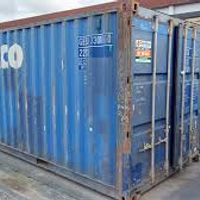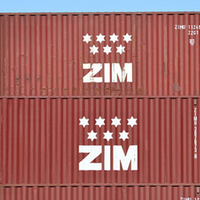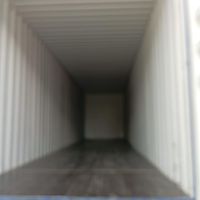The shipping container market is the backbone of global trade, moving over 90% of the world’s goods. As an industry player, keeping your finger on the pulse when it comes to container prices, market trends, and predictions is essential. Read this blog for a full update.
The container market is predicted to expand by 3-4% in both 2024 and 2025, and is currently valued at over US $10.2 billion. However, despite strong industry growth and a promising forecast over the next 7 years, a lack of transparency between players means that sourcing affordable containers from reliable suppliers is still a major challenge.
Luckily, the Container xChange trading marketplace provides transparency, reliability, and negotiable container prices—all in one place. We’ve got over 100,000 units available from 1,700 vetted and pre-approved partners.
So on our platform, you can make stress-free purchase decisions for your business. And best of all? There are no middlemen hiking up the prices and wasting your precious time.
To see our marketplace live in action, check out our public container search to find offers that fit your budget and requirements right now.
9,359 results found on the platform.
Container prices start from $400/unit.
Currently no match for your search
Change your search criteria or fill out the form below to get notified via email when there is a new match for you on xChange!
-
Pick-up

20DC (Cargo worthy)
3 units available
YOM:
Year of manufacture:
2004
2010
Savannah, GA
per container
Non-negotiable price$
1090
-
Pick-up

20DC (Cargo worthy)
6 units available
YOM:
Year of manufacture:
2004
2010
Savannah, GA
per container
Non-negotiable price$
1090
-
Pick-up

40HC (Brand new)
20 units available
YOM:
Year of manufacture:
2024
2024
Yekaterinburg, Sve
per container
Negotiable price$
1800
Showing 3 of 9,359 results
Load more()
YOM:
Year of manufacture:
per container
$
Shipping container market overview: Trends and growth forecast
The global shipping container market is estimated to reach US $14,1 billion by 2031. A CAGR of 4.1% is predicted over this period (2023–2031).
The forecast suggests a healthy upward trend over the next 7 years, with a consistent increase in market value year over year. This means we can expect an increasing demand for shipping containers, driven by ever-expanding global trade. The growing demand also highlights the need for effective logistics solutions in order to support the industry as it scales.
The graph below illustrates the container market’s past, present, and future trajectory between the years 2019 and 2031.
It shows the actual market values between 2019 and 2022 in USD, along with the forecasted CAGR from 2023 to 2031. Here, the upward trend in market value over the next 7 years is evident.

In terms of container volume, we can expect an annual growth rate of 3.6-3.8% over the next two years. This is a huge jump from 2023, when the growth rate remained below 0.5%.
Key drivers of market growth
What is driving market growth in the shipping industry at present? Here are some of the key factors:
- Increasing demand for containerized shipping services: An increasing number of businesses are now opting for containerized shipping due to its efficiency, reliability, and cost-effectiveness compared to other transport methods.
- The expansion of global trade networks: As global trade networks continue to expand, the demand for standard shipping containers grows. Standard containers allow for the most efficient and streamlined cross-border shipping.
- The use of blockchain technology in shipping: Blockchain shipping technology increases transparency and security in shipping transactions, reduces fraud and human errors, and increases trust between partners in the industry.
- The automation of port operations: Automation has allowed ports to become safer, more efficient and to reduce overall labor costs. Automated systems increasingly handle processes like container loading and unloading, inventory management, and vessel navigation.
Now let’s take a look at shipping trends along important trade routes around the world.
Container market: Shipping trends in popular trade routes
The global market relies heavily on its integrated network of trade routes to function optimally. Let’s look at some of the most popular routes, considering long-distance (head-haul) and regional trade lanes.
Head-haul shipping routes
Trans-Pacific route (Asia-North America): This high-volume route faces potential slowdowns due to rising inflation in the US, but remains essential for Asian exports.
Asia-Europe: The Asia-Europe lane is experiencing a period of adjustment since the Red Sea crisis began in October 2023. Due to attacks in the area, the majority of shippers have chosen to reroute around the Cape of Good Hope instead.
Blank sailings by shipping lines indicate a cautious approach to balancing capacity and demand.
Regional shipping routes
Intra-Asia: Strong regional trade ties and bustling manufacturing hubs fuel the growth trajectory of the intra-Asia route over the forecasted period.
North-South (developed-developing economies): This sector appears set for expansion, driven primarily by trade in raw materials and manufactured goods.
Influence of the Red Sea crisis on popular shipping routes
Once shipping volumes return to pre-crisis levels in the Red Sea, we are likely to see the following consequences:
Currently, ships have been traveling around the Cape of Good Hope to avoid the conflicted regions. With the re-opening of the Red Sea route in time, voyage times will drastically decrease, and along with this, freight rates on the Asia-Europe route are likely to drop.
Routes that have seen an increase in traffic during the Red Sea crisis—like those around Africa—can expect a decrease in volume once ships start using traditional routes again.
Want to keep your finger on the pulse when it comes to current shipping trends, container prices and industry news? Subscribe to our monthly logistics report: ‘Where Are All the Containers?’ to get the latest updates right in your inbox—for free! Download the report now.
Average container prices in the market
If you’re in the container industry, it’s important to keep up-to-date with the latest shipping container prices, so you can spot a good deal when you see one, and avoid being overcharged for units. Here are the prices for standard dry containers on the Container xChange platform.
20ft standard container
The 20ft shipping container is one of the most common container types in the market. They’re easy to stack on vessels and cheaper to ship than larger containers.
For a cargo-worthy 20ft container in Los Angeles, you’ll shell out just US $1,340, in New York, US $1,277 and in Long Beach, US $1,393. To find more great offers on used 20ft units, browse and compare options for yourself on xChange now.
40ft standard container
The 40ft has double the capacity of the 20ft, but is usually only 20-30% more expensive. So if you’ve got larger cargo volumes, one 40ft will work out much cheaper than 20ft units. See for yourself.
For a 40ft dry container in Los Angeles, you’ll pay US $1,496, in New York, US $1,291 and in Long Beach, US $1,372.
Want to take advantage of low prices on 40ft containers? Don’t wait; find offers that match your requirements on our marketplace today.
40ft HC standard container
If you’ve got taller cargo, or can’t quite fit everything into a standard 40ft, don’t worry—the 40ft high cube is your simple solution. This size has an extra foot of height.
To buy a 40ft high cube in Los Angeles on our marketplace, you’ll shell out just US $1,550. In New York, you’re looking at US $1,390, and in Long Beach, US $1,753.
Common challenges in the shipping container industry
Although the shipping container market is growing, it continues to face major challenges along the way. Here are some of the biggest obstacles at present.
Port congestion
Port congestion happens when ships idle outside of ports due to lack of capacity. This means delays in docking, unloading and reloading cargo.
Port congestion is often due to surges in global trade, infrastructure limitations and inefficiently managed port operations. It leads to delays in the supply chain, affecting delivery of goods, shipping costs, and production.
In recent months, Maersk has faced significant terminal congestion in the Mediterranean, as well as in Asia. This has forced them to skip sailings from China and South Korea. Waiting times have also increased across all major Chinese ports, with ships in Shanghai taking up to 5 days to berth.
Other ports such as Durban (South Africa), Jebel Ali (UAE) and Vancouver (Canada) have faced some of the highest levels of congestion over the past two months, leading to delays of between 3.5 and 8 days.
Although port congestion is a complex issue, possible solutions include extending port hours, improved coordination between players, and making use of digital tools such as container tracking and scheduling to improve visibility.
Container imbalances
Container imbalances occur when there’s a container surplus in some locations and a deficit in others. This leads to units being moved empty to accommodate shortages. Repositioning empty shipping containers is an expensive affair, and wastes valuable resources such as ship fuel.
Avoid empty container repositioning by leasing SOC containers on the xChange platform. This way, you can dodge expensive demurrage and detention fees and even get paid to move units for other shippers. Find out more here.
Inefficient cargo handling
When cargo is handled inefficiently, there’s an increased risk of errors and damage to cargo—which can be expensive for all parties involved. Inefficient cargo handling also leads to bottlenecks in the supply chain.
Possible solutions to ineffective cargo handling involve the use of automation and robots for loading and unloading, implementing real-time tracking and monitoring for cargo and equipment, and modernizing port machinery.
Market outlook beyond 2025
The shipping container market outlook past 2025 is positive; however, it won’t be without its hurdles. Here are some of the biggest potential threats to growth post-2025.
Sustainability pressures: With environmental concerns on the rise, we can expect an increase in regulations in the shipping industry. This will include ships switching to cleaner fuels and sustainable ports becoming essential.
Complying with environmental regulations will increase the costs for shipping lines and ports during the transition and adoption phase. This could lead to increased port charges, tariffs and shipping costs.
Geopolitical tensions: Ongoing conflicts such as the Red Sea Crisis and territorial disputes in the South China Sea are likely to continue to disrupt supply chains and cause capacity fluctuations going forward.
Along with the challenges, there are also some significant opportunities for improvement, such as:
Technological advancements: The increased use of AI and blockchain has the potential to enhance efficiency and increase transparency. This means greater trust between players in the industry, faster delivery times, and massive cost savings all round.
Infrastructure development: The automation and digitalization of port operations has the potential to streamline port activities, reduce human error and improve safety. Besides this, developing inland waterways and better multimodal transport networks could help to reduce container traffic.
Make the most of the market, buy shipping containers at best prices on Container xChange
Getting the containers you need at a price that suits your budget is easier than you think—if you use our marketplace as your sourcing channel. Plus, you can finally get the market transparency you’ve been looking for.
Here are four quick and easy steps to finding quality containers from reputable industry names—hassle-free.
Browse and compare offers
To start finding the containers you need, simply type your criteria into the public search bar to see a list of containers that match your requirements.

On the platform, you’ll see the container condition, price, and supplier for each offer upfront. You can also check the reviews, ratings and write ups of any supplier on our marketplace before deciding who to work with.
Negotiate with the seller
Once a container offer catches your eye, reach out to the seller directly to negotiate a deal that suits you both. The best part? On xChange there are no middlemen, so you’ll save both time and money.
Make safe payments
Lastly, you can pay for your containers using our secure payment feature. Finally, have only one payment partner and track all your transactions on the platform.
Confirm the container quality
You’ll get a 7-day window to inspect your containers and make sure you’re satisfied with your purchase.
If the containers you receive don’t match the offer, we’ll be here to assist with the mediation process between you and the partner. You can choose to either swap the units or get your money back.
Transparent container prices, reliable partners, and broker-free deals could be your reality with the Container xChange marketplace. Get started today! Click the banner below to set up your free demo. You’ll get a personalized tour and a chance to see the trading platform live in action.
Container market: Common FAQs
How big is the shipping container market?
The global shipping container market was valued at US $10.2 billion in 2023. It is estimated to reach US $14,1 billion by 2031, growing at a CAGR of 4.1% between 2023 and 2031.
What are the major challenges in the container market?
Major challenges faced by the shipping container market include container imbalances, inefficient cargo handling and port congestion. These issues cause delays in the supply chain and increase shipping costs.
What is the outlook for the shipping container market?
The shipping container market is predicted to reach $14,1 billion by 2031. Container volume is set to grow by 3-4% in 2024 and 2025, with factors such as digitization, automation, and blockchain technology aiding in such growth.











